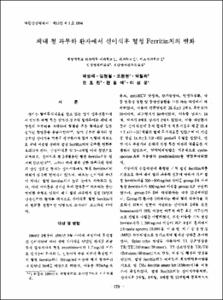KUMEL Repository
1. Journal Papers (연구논문)
1. School of Medicine (의과대학)
Dept. of Internal Medicine (내과학)
체내 철 과부하 환자에서 신이식후 혈청 Ferritin치의 변화
- Keimyung Author(s)
- Park, Sung Bae; Kim, Hyun Chul; Cho, Won Hyun; Park, Choal Hee; Chun, Hyo Jin; Jeon, Dong Seok; Lee, Sung Mun
- Department
- Dept. of Internal Medicine (내과학)
Dept. of Surgery (외과학)
Dept. of Urology (비뇨의학)
Dept. of Laboratory Medicine (진단검사의학)
Dept. of Radiology (영상의학)
- Journal Title
- 대한신장학회지
- Issued Date
- 1994
- Volume
- 13
- Issue
- 1
- Abstract
- Background: Following successful kidney transplantation, renal anemia is corrected during the first 3〜4 months and serum ferritin (SF) levels decreased markedly during the first 3 months posttransplant. However, renal transplant recipients (RTR) with severe iron overload had a gradual decrease of SF levels after transplantation. It is suggest that evolution of SF levels after transplantation is mainly determined by previous state of iron storage.
Methods: Twenty-four patients (16 mates, 8 females, mean age 35.6± 2.2 years) underwent renal transplantation between February 1989 and September 1992. All patients were living-donor kidney recipients with high basal SF levels (> 350 ng/ml). Group I (N = 12, SF: 350 〜800 ng/ml) had above normal basal SF levels and Group II (N = 12, SF: > 800 ng/ml) had a high basal SF levels. SF levels quantified with microparticled enzyme immunoassay technique in all patients at pretransplant, 3,6, 9 and 12 months after transplantation, five patients in group II were intermittent phlebotomized 3 months after transplantation. Magnetic resonance (MR) images of 6 patients were obtained using a 2.0 tesla spectro 20, 000.
Results: Mean Hb Levels increased in 24 RTR from 7. 3±0.2g/dl before transplantation to 13.3±0.3g/dl 3 months after transplantation. The mean SF level of Group I showed a rapid decreased from 572±37 ng/ml before transplantation to 195±60 ng/ml at 3 months after transplantation. In Group II, the mean SF level decreased gradually from 1.806 ±389 ng/ml before transplantation to 1.084±387 ng/ml, 774±147 ng/ml, at 6 months and 12 months posttransplant. At the 24 months posttransplant, mean SF level was 616±99 ng/ml. Five patients of Group II who underwent intermittent phlebotomy, SF level decreased from 2,384±641 ng/ml before transplantation to 1,094±278 ng/ml at 12 months posttransplant. MR imaging of 6 patients in Group II (basal SF: > 1,000 ng/ml) was evaluated. Signal intensity of liver was relatively lower than paraspinal muscles and nearly equal to background noise.
Conclusion: RTR with high basal SF or hemochromatosis should receive more intensive form of therapy including intermittent phlebotomies for prevent progress to subsequent liver dysfunction. SF level be monitored with regular intervals because of their persistent high ferritin levels after transplantation. Also, MR imaging serve as a noninvasive diagnostic tool and guidance for therapeutic decisions.
연구배경 : 장기혈액 투석치료를 받고 있는 말기 신부 전 환자에서 빈번한 수혈 흑은 장기간 경구적 철제투여 는 체내철 과부하를 초래하여 혈철중 흑은 혈색소중과 같은 합병중을 유발시킨다. 성공적인 신장이식후 말기 신부전 환자에서 빈혈의 호전과 함께 혈청 ferritin치의 현저한 감소가 일어난다. 그러나 체내철이 과부하된 상 태의 만성 신부전 환자에서는 신이식후에도 혈철 ferritin 치의 감소가 서서히 일어나고, 때로 신이식후 수년 간 혈청 ferritin치가 매우 높은 상태로 지속되고 있다. 체내철이 과부하된 신이식 환자를 대상으로 신이식후 빈 혈 개선과 함께 혈청 ferritin치의 변화를 알기 위하여 본연구를시행하였다.
방법 : 1989년 2월부터 1992년 9월까지 계명의대 동산 병원 신이식팀에 의해 생체신이식수술을 받고 혈청 creatinine치가 1.7mg/mi 이하로 350ng/ml 이상의 신 이 식 환자 24예를 대 상으로 하였다. 기저 혈청 ferritin 치를 기준으로 하여 group 1(350〜800ng/ml)와 group II(〉800ng/ml)으로 구분하여 신이식후 매 3개 월 간격으로 혈청 ferritin치룔 측정하여 분석하였다. Group II대상환자중 혈청 ferritin치가 1,000ng/ml 이 상인 6명에게 자기공명영상을 이용하여 침범된 장기 영 상을 조사하였다. 또한 체내철 과부한 적극적인 치료를 위해서 5명의 환자에서 신이식후 3개월부터 간헐적인 사 혈을 시행하였다.
결과: Groups 대상환자에서는 혈청 ferritin치의 변화가 신이식후 첫 3개월에 빈혈 개선과 함께 정상범위 내로 급속히 회복하였다. Group II에서는 기저치가 1.805±387ng/ml에서 신이식후 6개월에 1.084士387 ng/ml, 12개월에 774±147ng/ml로 지속적으로 고혈청 ferritin 치를 나타내고 신이식후 2년이 경과되어도 616±99ng/ml로 고혈청 ferritin치가 지속되었다.
자기공명영상에서 T1 및 T2 강조영상 모두에서 간 장,비장에서 신호강도가 현저하게 낮아서 장기 부위가 매우 어들게 보였다. 5명에서 신이식후 3개월부터 평균 11.6±2.6pint의 간헐적 사혈을하였으며 이들의 1년후 혈청 ferritin 감소율은 49.2±10,4%이었다.
결론 : 체내철 과부하에 따른 합병증 방지를 위해서 신 이식후 정기적인 혈청 ferritin의 추적검사가 필요하며, 체내철의 과부하가 심한 환자에서는 혈색소중 및 혈철침 착중의 예방 또는 치료를 위해서는 매주 혹은 격주의 간 헐적인 사혈 또는 desferioxamine 주사와 같은 보다 적 극적인 치료가 필요하며 이의 진단 및 치료경과 확인을 위해서는 비침습적인 자기공명영상 진단법이 매우 유용 한방법으로생각된다.
- Alternative Title
- Evolution of Serum Ferritin Levels in Renal Transplant Recipients with Severe Iron Overload
- Publisher
- School of Medicine
- Citation
- 박성배 et al. (1994). 체내 철 과부하 환자에서 신이식후 혈청 Ferritin치의 변화. 대한신장학회지, 13(1), 179–186.
- Type
- Article
- ISSN
- 1225-0015
- Appears in Collections:
- 1. School of Medicine (의과대학) > Dept. of Internal Medicine (내과학)
1. School of Medicine (의과대학) > Dept. of Laboratory Medicine (진단검사의학)
1. School of Medicine (의과대학) > Dept. of Radiology (영상의학)
1. School of Medicine (의과대학) > Dept. of Surgery (외과학)
1. School of Medicine (의과대학) > Dept. of Urology (비뇨의학)
- 파일 목록
-
-
Download
 oak-bbb-02499.pdf
기타 데이터 / 466.46 kB / Adobe PDF
oak-bbb-02499.pdf
기타 데이터 / 466.46 kB / Adobe PDF
-
Items in Repository are protected by copyright, with all rights reserved, unless otherwise indicated.